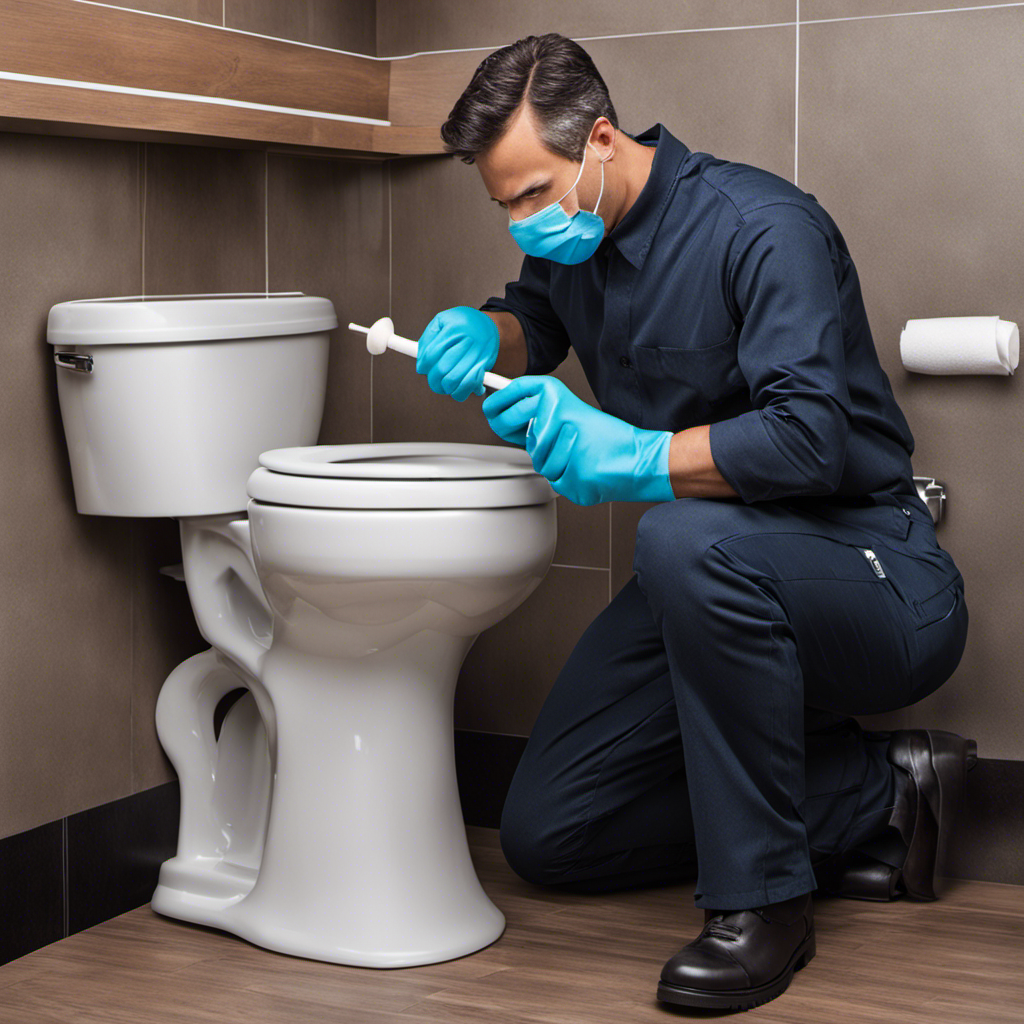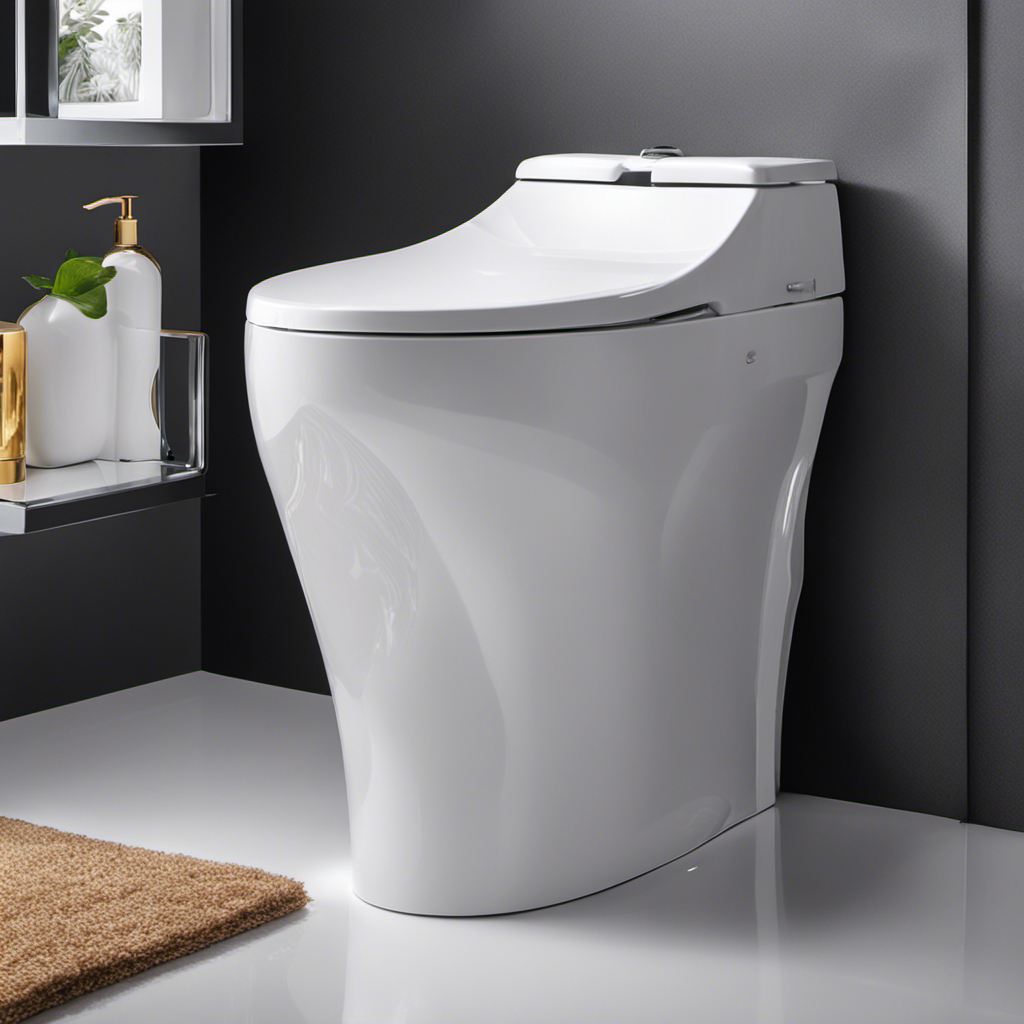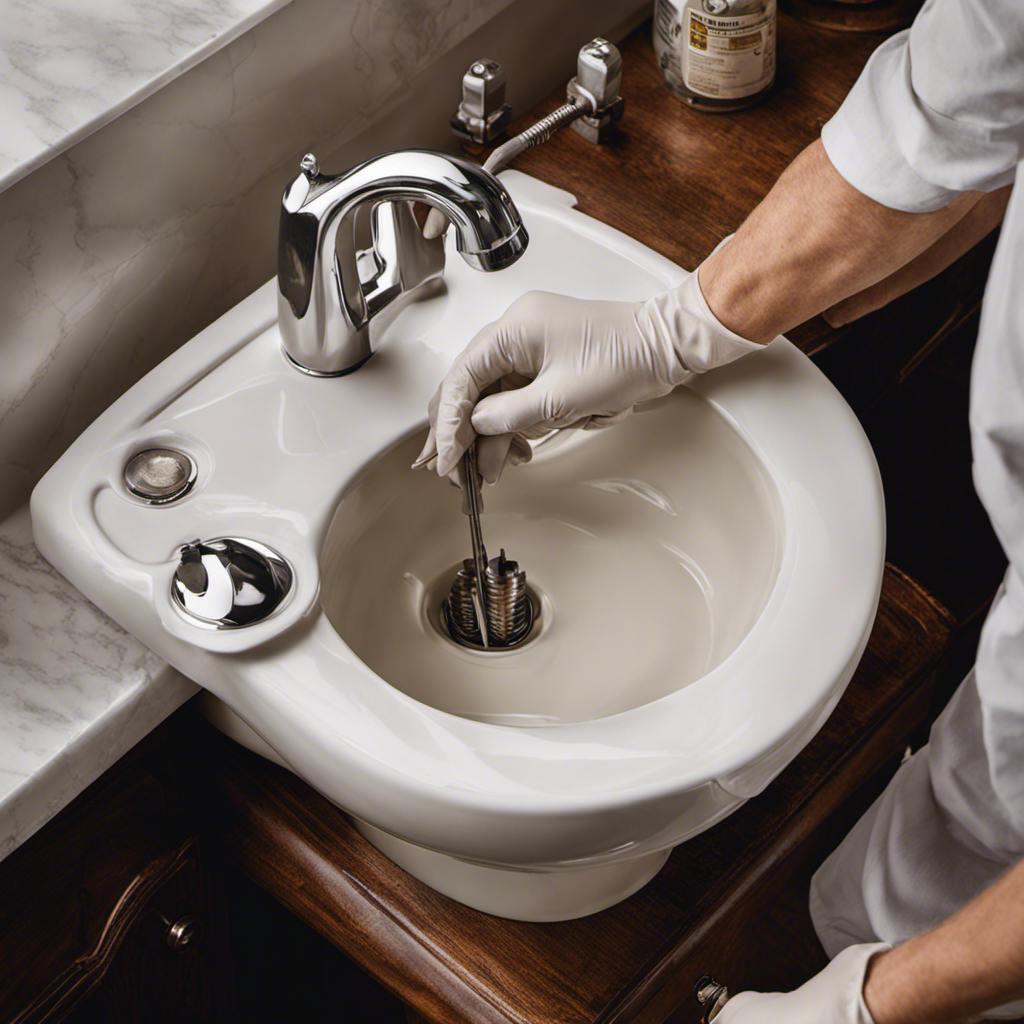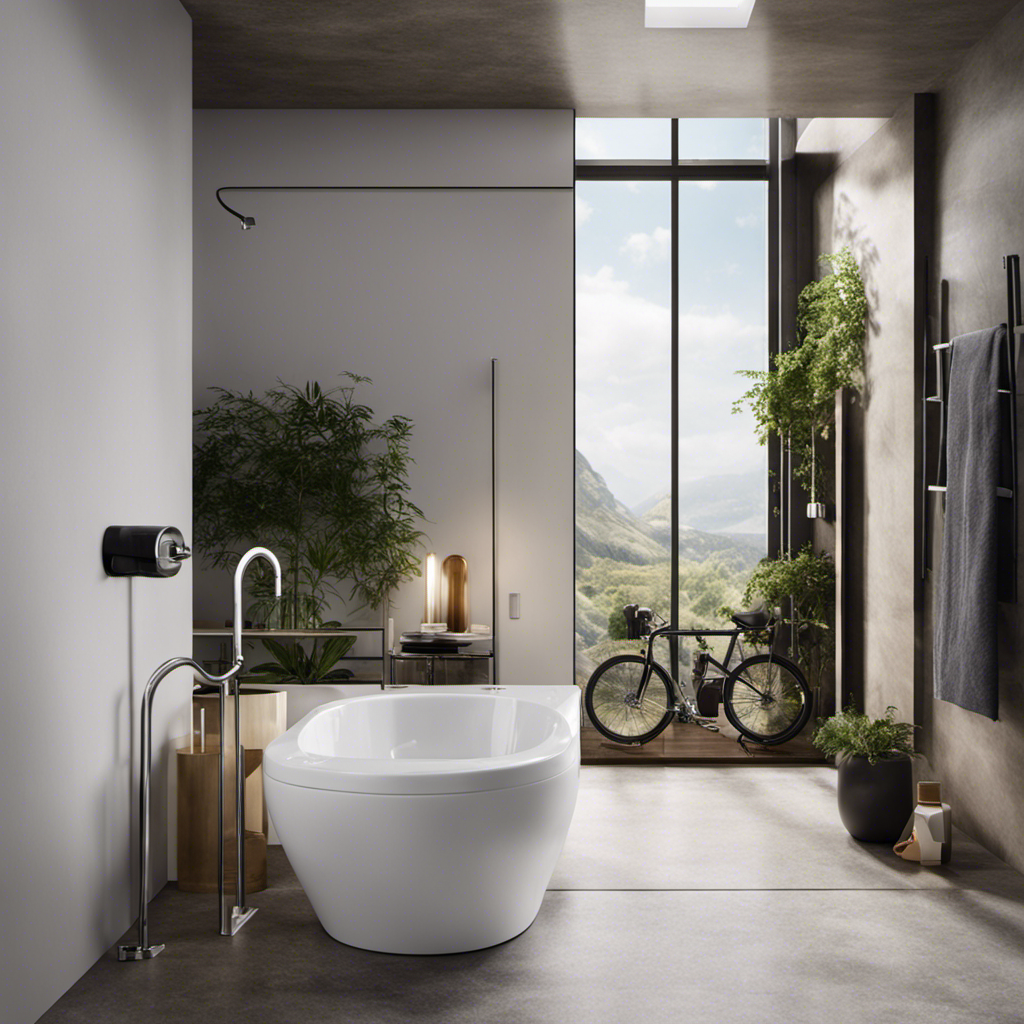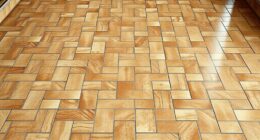I’ve had my fair share of plumbing mishaps, but one thing I’ve learned is the importance of knowing how to correctly plunge a toilet.
In this article, I will guide you through the step-by-step process of effectively unclogging your toilet. From the tools you’ll need to common mistakes to avoid, I’ll provide you with all the knowledge and tips you need to tackle even the most stubborn toilet clogs.
So let’s dive in and learn how to keep your toilet running smoothly!
Key Takeaways
- Proper plunging technique is crucial for successfully unclogging a toilet
- Using a plunger with a flange and creating a tight seal is important for effective plunging
- Up and down motions with firm pressure create suction and dislodge the clog
- Additional tools like a bucket of water, gloves, and safety goggles can aid in the plunging process
Importance of Proper Plunging Technique
The importance of using proper plunging technique cannot be overstated. When it comes to unclogging a toilet, the effectiveness of plunging directly impacts the success of the task.
Proper plunging technique involves creating a tight seal between the plunger and the toilet bowl, using an up and down motion to create pressure and suction. By doing this correctly, you can effectively dislodge any blockages and restore normal toilet function.
On the other hand, the consequences of improper plunging can be problematic. Insufficient pressure or an improper seal can result in ineffective plunging, leading to a prolonged clog or even potential damage to the toilet. Additionally, improper plunging can cause water to overflow, leading to a messy and unsanitary situation.
To avoid these issues, it is crucial to approach plunging with the correct technique and knowledge.
Tools Needed for Effective Toilet Plunging
When it comes to effective toilet plunging, having the right equipment is essential. Proper tool selection can make all the difference in successfully unclogging a toilet.
In this discussion, we will explore the essential plunging equipment, delve into the importance of proper tool selection, and learn the best techniques for achieving optimal results.
Essential Plunging Equipment
To effectively plunge a toilet, you’ll need a plunger and a bucket of water. Here are three essential plunging equipment for a safe and successful toilet plunge:
-
Plunger with a flange: This type of plunger has a rubber flange at the bottom, which creates a better seal around the drain opening. The flange helps to deliver more force and pressure, making it easier to clear the clog.
-
Bucket of water: Before plunging, fill a bucket with water and pour it into the toilet bowl. The additional water helps to increase the pressure and create a stronger force when plunging, aiding in dislodging the clog.
-
Gloves and safety goggles: Toilet plunging can sometimes be messy, so it’s important to protect yourself. Wear gloves to avoid direct contact with any potential contaminants and safety goggles to protect your eyes from splashes.
With the right plunger and safety precautions in place, you can now move on to the next step: proper tool selection.
Proper Tool Selection
Now that you have the necessary equipment, it’s important to choose the right tool for the job.
When it comes to toilet plunging safety, different types of plungers can make a significant difference.
The most common type is the cup plunger, which has a flat bottom and a rubber cup that creates a seal around the drain opening. This type is effective for minor clogs and can be used on both toilets and sinks.
For more stubborn clogs, a flange plunger is recommended. The flange, or extended rubber lip, fits into the toilet drain opening and provides extra force to dislodge the blockage.
It’s crucial to select a plunger that is specifically designed for toilets, as using the wrong type can lead to damage or ineffective plunging.
Remember to always prioritize safety by wearing gloves and taking precautions to avoid splashing.
Best Plunging Techniques
Remember, the key to effective plunging is applying firm, rhythmic pressure to create suction and dislodge the clog.
Here are the best plunging techniques that will help you unclog your toilet with ease:
-
Position the plunger: Place the plunger over the drain hole, ensuring a tight seal between the plunger and the toilet bowl.
-
Pump the plunger: Push down firmly on the plunger and then pull up quickly, repeating the motion several times. The suction created will help dislodge the clog.
-
Use hot water: For stubborn clogs, try pouring hot water into the toilet bowl before plunging. The heat can help break down the clog and make plunging more effective.
By following these tips for effective plunging, you’ll increase your chances of successfully unclogging your toilet.
Now, let’s move on to the step-by-step guide to plunging a clogged toilet.
Step-by-Step Guide to Plunging a Clogged Toilet
When it comes to plunging a clogged toilet, proper technique is crucial for a successful outcome.
In this discussion, I will be covering the key points of proper plunging technique and the common mistakes to avoid.
Proper Plunging Technique
To properly plunge a toilet, make sure to create a tight seal with the plunger. This is crucial for effective unclogging and preventing any mess. Here are three tips for mastering the proper plunging technique:
-
Position the plunger: Place the plunger over the drain hole, ensuring it covers the entire opening. Press it firmly against the surface to create a secure seal.
-
Apply steady pressure: Push the plunger down gently but firmly, and then pull it up quickly. Repeat this motion several times without breaking the seal. The suction created will help dislodge the blockage.
-
Be patient and persistent: It may take several attempts before the clog is fully cleared. Stay consistent with your plunging technique and do not rush the process.
Common Mistakes to Avoid
If you rush the process or break the seal, you could worsen the clog instead of resolving it. When it comes to plunging a toilet, there are some common mistakes that people often make. It’s important to avoid these pitfalls to ensure an effective plunging experience. Here are some tips for effective plunging and the common mistakes to avoid:
| Common Mistakes to Avoid | Tips for Effective Plunging |
|---|---|
| Using too much force | Start with gentle pressure |
| Not creating a seal | Press the plunger firmly |
| Plunging too quickly | Maintain a steady rhythm |
| Neglecting to clear the trap | Plunge multiple times |
Common Mistakes to Avoid When Plunging a Toilet
One of the most common mistakes to avoid when plunging a toilet is not creating a proper seal with the plunger. Without a good seal, you won’t be able to generate the necessary suction to unclog the toilet effectively.
To ensure a proper seal, follow these three steps:
-
Position the plunger: Place the plunger over the drain hole in the toilet bowl, making sure it covers the entire hole. Hold it firmly, ensuring a tight seal.
-
Apply downward pressure: Push down on the plunger handle to create suction. This will help dislodge the clog and allow water to flow freely.
-
Use a vigorous plunging motion: With the plunger still firmly in place, rapidly push and pull it up and down. This action will help break up the clog and clear the drain.
By creating a proper seal and following these steps, you can effectively unclog your toilet and maintain its proper functioning.
Tips for Dealing With Stubborn Toilet Clogs
Dealing with stubborn toilet clogs can be frustrating, but there are effective methods to resolve the issue. When faced with a clogged toilet that won’t budge, it’s important to explore alternative solutions before resorting to calling a plumber.
DIY unclogging methods can often save time and money. One method is to use a toilet auger, also known as a plumber’s snake, which can help break up the clog and allow water to flow freely. Another option is to make a homemade drain cleaner using a mixture of baking soda and vinegar. Pouring this down the toilet can help dissolve the clog and clear the drain. Additionally, using a plunger in the correct way can also provide a quick fix.
Remember to be patient and persistent when attempting these DIY methods, as it may take a few tries to completely resolve the issue.
How to Prevent Future Toilet Clogs
To prevent future toilet clogs, you should regularly maintain the plumbing system in your home. Here are three important steps you can take to prevent clogged drains and maintain your toilet plumbing:
-
Use a drain strainer: Install a drain strainer in your bathroom sink and shower to catch hair, soap residue, and other debris that can lead to clogs. Empty the strainer regularly to keep the drains flowing smoothly.
-
Avoid flushing non-flushable items: Only flush toilet paper and human waste down the toilet. Flushing items like diapers, wipes, or feminine hygiene products can easily lead to clogs in the plumbing system.
-
Schedule regular professional inspections: Hire a professional plumber to inspect your plumbing system at least once a year. They can identify potential issues and perform necessary maintenance to prevent clogs and other plumbing problems.
By following these preventive measures, you can reduce the chances of experiencing future toilet clogs and keep your plumbing system in good condition.
However, if you do encounter a clog, there are alternative methods for unclogging a toilet that can be effective.
Alternative Methods for Unclogging a Toilet
If you’re experiencing a clog in your toilet, a helpful alternative method is using a toilet auger. This tool, also known as a plumber’s snake, is designed to break up and remove stubborn clogs that a plunger may not be able to handle. To use a toilet auger, simply insert the end of the auger into the toilet bowl and turn the handle clockwise to feed the cable into the drain. Once the auger reaches the clog, continue turning the handle to break it up. Then, slowly retract the auger, being careful not to scratch the toilet bowl. This method is effective for removing most clogs, but for more stubborn ones, you may need to repeat the process or try other toilet unclogging hacks or natural remedies for unclogging toilets.
| Toilet Unclogging Hacks | Natural Remedies for Unclogging Toilets |
|---|---|
| Use a toilet auger | Pour boiling water into the toilet bowl |
| Try a plunger | Use a mixture of baking soda and vinegar |
| Use a drain snake | Use a combination of dish soap and hot water |
| Try a toilet bomb | Use a wet/dry vacuum |
Frequently Asked Questions
Can I Use Any Type of Plunger to Unclog a Toilet?
Yes, you can use different types of plungers to unclog a toilet. However, it’s important to know how to properly use a plunger to achieve the best results. Let me explain.
What Should I Do if the Toilet Bowl Overflows While Plunging?
If the toilet bowl overflows while plunging, stop plunging immediately and turn off the water supply valve behind the toilet. Use a bucket to remove excess water and then continue plunging.
Is It Necessary to Wear Gloves When Plunging a Toilet?
Personally, I always wear gloves when plunging a toilet. It provides protection from germs and bacteria, preventing potential infections. However, alternatives like using plastic bags or washing hands thoroughly afterward can also be effective.
Can Plunging a Toilet Cause Any Damage to the Plumbing System?
Plunging a toilet can potentially cause damage to the plumbing system if done incorrectly. It’s important to know the proper technique and not rely solely on force. Prevention is key to avoiding clogs.
Are There Any Home Remedies I Can Use to Unclog a Toilet Instead of Using a Plunger?
Sure, there are alternative methods and home remedies to unclog a toilet. One interesting statistic is that using dish soap and hot water can help break down the clog.
Conclusion
In conclusion, mastering the art of plunging a toilet is like taming a wild beast. By carefully following the steps and using the right tools, you can conquer even the most stubborn clogs.
Remember, patience and perseverance are key. Don’t be discouraged by setbacks and always strive to improve your technique.
With practice, you’ll become a toilet-plunging master, ready to face any clog that comes your way.
So go forth, fearless plungers, and keep those toilets flowing smoothly. Happy plunging!
